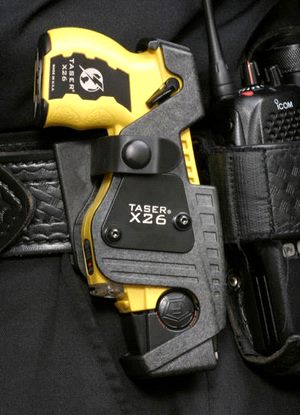
The Federation of Community Legal Centres has long been concerned that Tasers should not be seen as the panacea to police use of a firearm.
There are significant risks that Tasers can kill or harm when used on vulnerable groups or in particular ways. These are the same vulnerable groups that are overrepresented in statistics relating to police use of lethal force in Victoria.
Evidence from overseas, and increasingly from Australia, suggests that Tasers are prone to misuse. We also know that use of lethal force by police can be avoided in most instances with tactical communication, nonviolent intervention and other lower use of force strategies.
Arming police with Tasers increases the likelihood that weapons rather than negotiation, containment, retreat and deescalation will be used when a difficult situation arises.
Victoria Police were first authorised to use Tasers as part of a 12 month trial in 2003. Tasers were trialled in Bendigo, Morwell, Traralgon, Moe, Geelong and Ballarat, and used by specialist units, such as critical response teams, in Melbourne.
In 2014, Tasers were rolled out to most frontline police in regional Victoria. As part of a $13.5 million government plan, 580 Taser weapons will be provided to all 24-hour police stations across regional Victoria. 1
What are Tasers?
A Taser is a brand of stun gun that uses electricity to subdue people.
Tasers are promoted by their proponents around the world as an alternative to police use of lethal force to resolve a critical incident.
Tasers can be used in two modes.
1. In Probe Mode a Taser shoots two barbed darts into a victim or their clothing following the release of compressed nitrogen. These two darts are connected to insulated wires that deliver multiple pulses of a 50,000 volt electrical current lasting over 5 seconds.
The electrical current causes involuntary stimulation of the sensory and motor nerves, resulting in muscle contractions and severe pain. The muscle contractions are intended to immobilise the victim by causing him or her to fall to the ground, regardless of the pain tolerance or mental focus of the individual.
2. In Drive-Stun Mode the weapon is pressed directly against the skin of a victim causing intense pain (and sometimes burns), but not causing any electro-muscular disruption.
In this second mode, the Taser is intended as a pain compliance tool.
Tasers can kill
The causal link between Tasers and death is hotly contested by researchers and advocates. Nevertheless the sheer numbers of Taser proximate deaths raises questions about the safety of the weapon.
Amnesty International reported in December 2008 that more than 330 people had died after police Taser shocks in the USA since 2001.
Canadian Broadcasting Corporation claims that there have been over 26 deaths attributable to Tasers in Canada since 2003.
TASER Resources
For Victorian and International resources on Taser use and abuse see our Research and Resources page.
Notes:
- 580 police Tasers to hit the streets across Victoria, The Age, Mex Cooper 23 April 2014 http://www.theage.com.au/victoria/580-police-tasers-to-hit-the-streets-across-victoria-20140423-373ds.html#ixzz2zmSqKkFN ↩
